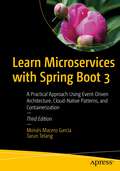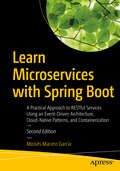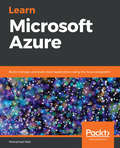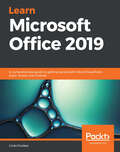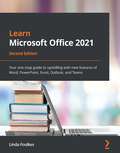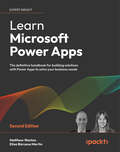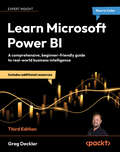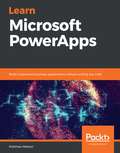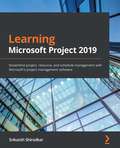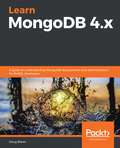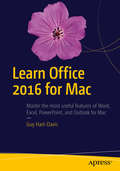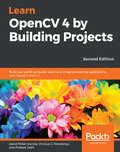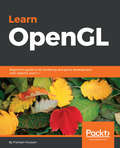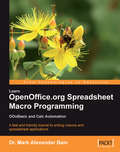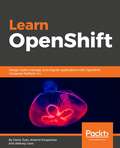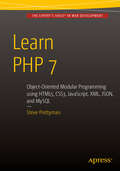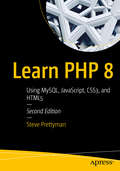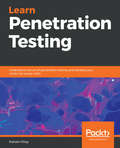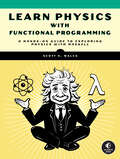- Table View
- List View
Learn Microservices with Spring Boot 3: A Practical Approach Using Event-Driven Architecture, Cloud-Native Patterns, and Containerization
by Moisés Macero García Tarun TelangThis book will show you how to build Java-based microservices architecture using the popular Spring Boot framework by evolving a small monolith application to an event-driven architecture composed of several services. This third edition has been updated to cover Spring Boot 3, including its compatibility with Java 17 and Jakarta EE 10, and employs an incremental approach to teach the structure of microservices, test-driven development, and common patterns in distributed systems such as service discovery, load balancing, routing, centralized logs, per-environment configuration, and containerization. Authors Moisés Macero and Tarun Telang get the ball rolling by introducing you to the fundamentals of microservices and Spring Boot before walking you through the development of a basic Spring Boot application. You’ll then see how to build a front end using React, and learn how to use the data layer to read and write data from and to other systems via Spring Boot and its access to Spring Data and its available APIs. Putting together what you've learned thus far, you’ll begin to transform an application from a monolith to a microservice. This pragmatic approach will enable you to better grasp the benefits of using this type of software architecture, instead of keeping you distracted with theoretical concepts. The emphasis is on what matters most, starting with the minimum viable product, while maintaining the ability to adapt and improve your application as needed. After completing this book, you will have the foundational knowledge necessary to build your own microservice-based applications using Spring Boot. What You Will Learn Gain a thorough understanding of microservices architecture and how it differs from monolithic architectures.Discover the step-by-step process of breaking down a monolithic application into smaller, focused servicesBuild microservices with Spring Boot 3, Spring Data, Spring Cloud, React.js, Docker, Cucumber, and moreDevelop Java-based microservices using the latest version of Spring Boot, compatible with Java 17 and Jakarta EE 10.Discover architecture patterns for distributed systems such as asynchronous processing, eventual consistency, resilience, scalability, and moreGain insight into event-driven communication patterns and understand how to design and build event-driven microservicesTrace every request from beginning to end with Sleuth and centralized loggingDeploy your microservices anywhere as Docker containers Who This Book Is For Those with at least some prior experience with Java programming. Some prior exposure to Spring Boot recommended but not required.
Learn Microservices with Spring Boot: A Practical Approach to RESTful Services Using an Event-Driven Architecture, Cloud-Native Patterns, and Containerization
by Moisés Macero GarcíaBuild Java-based microservices architecture using the Spring Boot framework by evolving an application from a small monolith to an event-driven architecture composed of several services. This revised book follows an incremental approach in teaching the structure of microservices, test-driven development, and common patterns in distributed systems such as service discovery, load balancing, routing, centralized logs, per-environment configuration, and containerization.This updated book now covers what's been added to the latest Spring Boot release, including support for the latest Java SE; more deep-dive knowledge on how Spring Boot works; testing with JUnit 5; changes in the Spring Cloud tools used for service discovery and load balancing; building Docker images using cloud-native buildpacks; a basic centralized logging solution; E2E traceability with Sleuth; centralized configuration with Consul; many dependency upgrades; support for Spring Data Neumann; and more.Author Moises Macero uses a pragmatic approach to explain the benefits of using this type of software architecture, instead of keeping you distracted with theoretical concepts. He covers some of the state-of-the-art techniques in computer programming, from a practical point of view. You’ll focus on what's important, starting with the minimum viable product but keeping the flexibility to evolve it.What You Will LearnBuild microservices with Spring BootDiscover architecture patterns for distributed systems such as asynchronous processing, eventual consistency, resilience, scalability, and moreUse event-driven architecture and messaging with RabbitMQMaster service discovery with Consul and load balancing with Spring Cloud Load BalancerRoute requests with Spring Cloud GatewayKeep flexible configurations per environment with Spring Cloud ConsulTrace every request from beginning to end with Sleuth and centralized loggingDeploy your microservices anywhere as Docker containersStart all the components in the microservice architecture with Docker ComposeWho This Book Is ForThose with at least some prior experience with Java programming. Some prior exposure to Spring Boot recommended but not required.
Learn Microsoft Azure: Build, manage, and scale cloud applications using the Azure ecosystem
by Mohamed WaliLearn Microsoft Azure is for administrators, cloud engineers, developers, and professionals who want to get started with using Azure as their cloud platform and build a cloud-based application for their enterprises.
Learn Microsoft Office 2019: A comprehensive guide to getting started with Word, PowerPoint, Excel, Access, and Outlook
by Linda FoulkesGet to grips with the complete range of Office 2019 applications, explore solutions to common challenges, and discover best practices for working productively Key Features Explore MS Office to enhance productivity and boost your professional development Get up and running with the new and improved features in Microsoft Office 2019 Discover how to overcome common challenges when working with Office 2019 applications Book Description Learn Microsoft Office 2019 provides a comprehensive introduction to the latest versions of Microsoft Word, Excel, PowerPoint, Access, and Outlook. With the help of illustrated explanations, this Microsoft Office book will take you through the updated Office 2019 applications and guide you through implementing them using practical examples. You'll start by exploring the Word 2019 interface and creating professional Word documents using elements such as citations and cover pages, tracking changes, and performing mail merge. You'll then learn how to create impressive PowerPoint presentations and advance to performing calculations and setting up workbooks in Excel 2019, along with discovering its data analysis features. Later chapters will focus on Access 2019, assisting you in everything from organizing a database to constructing advanced queries. You'll then get up to speed with Outlook, covering how to create and manage tasks, as well as how to handle your mail and contacts effortlessly. Finally, you'll find solutions to commonly encountered issues and best practices for streamlining various workplace tasks. By the end of this book, you'll have learned the essentials of Office business apps and be ready to work with them to boost your productivity. What you will learn Use PowerPoint 2019 effectively to create engaging presentations Gain working knowledge of Excel formulas and functions Collaborate using Word 2019 tools, and create and format tables and professional documents Organize emails, calendars, meetings, contacts, and tasks with Outlook 2019 Store information for reference, reporting, and analysis using Access 2019 Discover new functionalities such as Translator, Read Aloud, Scalable Vector Graphics (SVG), and data analysis tools that are useful for working professionals Who this book is for Whether you're just getting started or have used Microsoft Office before and are looking to develop your MS Office skills further, this book will help you to make the most of the different Office applications. Familiarity with the Office 2019 suite will be useful, but not mandatory.
Learn Microsoft Office 2019: A comprehensive guide to getting started with Word, PowerPoint, Excel, Access, and Outlook
by Linda FoulkesPublisher\'s note: This edition is based on MS Office 2019 and does not make use of the most recent features in MS Office 2021. A new second edition, updated for MS Office 2021 including new topics and the latest productivity feature enhancements for Office web and desktop has now been published.Key FeaturesExplore MS Office to enhance productivity and boost your professional developmentGet up and running with the new and improved features in Microsoft Office 2019Discover how to overcome common challenges when working with Office 2019 applicationsBook DescriptionLearn Microsoft Office 2019 provides a comprehensive introduction to the latest versions of Microsoft Word, Excel, PowerPoint, Access, and Outlook. With the help of illustrated explanations, this Microsoft Office book will take you through the updated Office 2019 applications and guide you through implementing them using practical examples. You'll start by exploring the Word 2019 interface and creating professional Word documents using elements such as citations and cover pages, tracking changes, and performing mail merge. You'll then learn how to create impressive PowerPoint presentations and advance to performing calculations and setting up workbooks in Excel 2019, along with discovering its data analysis features. Later chapters will focus on Access 2019, assisting you in everything from organizing a database to constructing advanced queries. You'll then get up to speed with Outlook, covering how to create and manage tasks, as well as how to handle your mail and contacts effortlessly. Finally, you'll find solutions to commonly encountered issues and best practices for streamlining various workplace tasks. By the end of this book, you'll have learned the essentials of Office business apps and be ready to work with them to boost your productivity.What you will learnUse PowerPoint 2019 effectively to create engaging presentationsGain working knowledge of Excel formulas and functionsCollaborate using Word 2019 tools, and create and format tables and professional documentsOrganize emails, calendars, meetings, contacts, and tasks with Outlook 2019Store information for reference, reporting, and analysis using Access 2019Discover new functionalities such as Translator, Read Aloud, Scalable Vector Graphics (SVG), and data analysis tools that are useful for working professionalsWho this book is forWhether you're just getting started or have used Microsoft Office before and are looking to develop your MS Office skills further, this book will help you to make the most of the different Office applications. Familiarity with the Office 2019 suite will be useful, but not mandatory.
Learn Microsoft Office 2021: Your one-stop guide to upskilling with new features of Word, PowerPoint, Excel, Outlook, and Teams, 2nd Edition
by Linda FoulkesTake your Microsoft Office skills to the next level by mastering the exciting new features and enhancements in Microsoft Office 2021, including communicating, collaborating, and presenting using TeamsKey FeaturesGet a progressive walkthrough of the new desktop and web apps with real-world examplesEnrich your skillset by learning new productivity feature enhancements for Office web and desktopDiscover how to use Microsoft Teams to communicate, collaborate, and present during meetingsBook DescriptionThis second edition book covers the new and exciting features of Microsoft Office 2021 for desktop and web apps, helping you broaden the skills from the previous edition. Using real-world experiences, this book will guide you through practical examples that set off your thought process to boost productivity.To build new skills in each application, the book ensures that you gain a thorough understanding of new functions, such as PivotTables, Dashboards, and data manipulation methods in Excel.You'll explore PowerPoint tools such as Presenter Coach, Presenter View, the record tool, and setting reading order to mention a few. You'll also manipulate slide elements using Auto Fix, draw features, insert video captions, explore playback options, and rehearse presentations using the body language Presenter Coach feature. The book demystifies the Transform feature and shows you how to dictate directly in Word. You'll even be able to work with Styles by refining the layout and multiple tables of contents. Finally, you'll focus on making the best use of Outlook enhancements and working remotely using Teams.By the end of this book, you'll have understood the features of each app inside out and enhanced your existing skills using new techniques to make your professional life more efficient.What you will learnUncover OneDrive features and Word enhancements such as dictation, co-authoring, embedding, styles, referencing, and media toolsManage Word document layouts, online forms, recording document automation, and track, compare, and combineCreate engaging PowerPoint presentations using Presenter Coach, Auto Fix, Record, and drawing toolsExplore Excel functions such as XLOOKUP, LET, XMATCH IFS, arrays and IFERROR, and VLOOKUPWork with database and COUNTIF functions, Advanced Filter, clean data, and PivotTables and DashboardsExplore Outlook enhancementsWho this book is forIf you work with Microsoft Office applications but are yet to discover the complete range of features, this second edition is tailored to broaden your skillset with new features and functionalities. It would be of value for those working in any industry and for students moving into the workplace or preparing for Microsoft Office certification. The book uses real-world practical workplace examples to help you get ready to apply your skills and make the most of the recent features of Microsoft Office.Although not a prerequisite, a solid understanding of the Microsoft Office applications will be beneficial.
Learn Microsoft Power Apps: The definitive handbook for building solutions with Power Apps to solve your business needs
by Matthew Weston Elisa Bárcena MartínA step-by-step guide that will help you create, share, and deploy applications across your organization using Microsoft Power Apps Purchase of the print or Kindle book includes a free PDF eBookKey FeaturesBuild apps from scratch to solve real-world business scenarios Learn how to keep app data secure with expanded coverage on DataverseIncorporate AI into your app building process using AI Builder and CopilotBook DescriptionMicrosoft Power Apps provides a modern approach to building low-code business applications for mobiles, tablets, browsers, and Microsoft Teams. The second edition of Learn Microsoft Power Apps will guide you in creating well designed and secure apps that transform old processes and workflows. Learn Microsoft Power Apps starts with an introduction to Power Apps to help you feel comfortable with the creation experience. Using screenshots from the latest UI, you will be guided through how to create an app, building your confidence to start developing further. This book will help you design, set up, and configure your first application by writing simple formulas. You'll learn about the different types of apps you can build in Power Apps and which one applies best to your requirements. In addition to this, you’ll learn how to identify the right data storage system for you, with new chapters covering how to integrate apps with SharePoint or Dataverse. As you advance, you’ll be able to use various controls, connectors, and data sources to create a powerful, interactive app. For example, this book will help you understand how Power Apps can use Microsoft Power Automate, Power BI, and Azure functionalities to improve your applications. Finally, you will be introduced to the emerging Power Apps Copilot tool, which uses artificial intelligence to accelerate the app building process. By the end of this Power Apps book, you’ll be ready to confidently develop lightweight business applications with minimal code.What you will learnUnderstand the Power Apps ecosystem and licensingTake your first steps building canvas appsDevelop apps using intermediate techniques such as the barcode scanner and GPS controlsExplore new connectors to integrate tools across the Power PlatformStore data in Dataverse using model-driven appsDiscover the best practices for building apps cleanly and effectivelyUse AI for app development with AI Builder and CopilotWho this book is forThis book is intended for business analysts, IT professionals, and both developers and non-developers alike. If you want to meet business needs by creating purpose-built apps, this book is for you. To get the most out of this book, it is recommended that you have a basic understanding of Microsoft 365 as you will interact with various elements of it while developing apps.
Learn Microsoft Power BI: A comprehensive, beginner-friendly guide to real-world business intelligence
by Greg DecklerHarness the power of Power BI, Microsoft Fabric, and Copilot to deliver insights that drive enterprise success. Now includes downloadable PowerPoint slides for each chapter and exclusive video tutorials in both classic and preview Power BI interfaces, ideal for educators and self-learners.Key FeaturesLearn Power BI from the ground up with real-world examples that cover both basic and advanced featuresDevelop powerful analytical models and reports that extract key business insightsPublish, share, and collaborate on reports, dashboards, apps, and goalsPurchase of the print or Kindle book includes a free PDF eBookBook DescriptionEveryone’s swimming in data. The ones who thrive? They know how to make sense of it with the right tools quickly and effectively. Learn Microsoft Power BI, Third Edition is your essential guide to mastering one of the most powerful platforms for data analysis and visualization. In this newly revised and expanded edition, Greg Deckler, a 7-time Microsoft MVP and Power BI expert, takes you on a journey of data exploration and discovery using Microsoft Power BI to ingest, cleanse, and organize data and uncover key business insights that can be shared effectively. Covering the latest features and interface changes, including Microsoft Fabric and Copilot, this book guides you through deploying, adopting, and governing Power BI within your organization. You’ll get to grips with the fundamentals of business intelligence projects and learn how to leverage your expertise in the broader Power BI ecosystem. From ingesting and cleansing your data to transforming it into stunning visualizations, reports, and dashboards that speak to business decision-makers, this book will fully prepare you to become the data analysis hero of your organization or kickstart a rewarding career in business intelligence.What you will learnUnderstand the fundamentals of Microsoft Fabric and CopilotPlan and manage your business intelligence projectsConnect to and transform data using Power QueryCreate semantic models and DAX calculations optimized for analysis and reportingUncover business insights and design professional reportsDeploy and govern Power BI, with a focus on gateways and deployment pipelinesWho this book is forIf you're a data analyst, IT manager, or BI user new to employing Power BI for solving business intelligence problems, this book is for you. It’s also a valuable resource for those looking to migrate from other BI tools and create powerful and interactive dashboards. No experience with Power BI, Microsoft Fabric, or Copilot is required.
Learn Microsoft PowerApps: Build customized business applications without writing any code
by Matthew WestonThis book is for Developers, non-developers and any IT professional who wants to learn Microsoft PowerApps to either start developing or want to expand their knowledge of development in PowerApps.
Learn Microsoft Project 2019: Streamline project, resource, and schedule management with Microsoft's project management software
by Srikanth ShirodkarExplore detailed explanations and examples to get up and running with the five phases of the project management lifecycle and integrate project management principles in a variety of projects Key Features Explore various algorithms and the latest features of MS Project to organize and keep track of your projects Understand Work Breakdown Structure (WBS) to improve productivity Apply real-world best practices and discover the tips, tricks, and pitfalls of schedule management Book Description Microsoft Project is one of the most popular project management tools for enterprises of all sizes thanks to its wide variety of features such as project scheduling, project budgeting, built-in templates, and reporting tools. Learning Microsoft Project 2019 will get you started with the basics and gradually guide you through the complete project life cycle. Starting with an overview of Microsoft Project 2019 and a brief introduction to project management concepts, this book will take you through the different phases of project management – initiation, planning, execution, control, and closure. You will then learn how to identify and handle problems related to scheduling, costing, resourcing, and work allocation. Understand how to use dynamic reports to create powerful, automated reports and dashboards at the click of a button. This Microsoft Project book highlights the pitfalls of overallocation and demonstrates how to avoid and resolve these issues using a wide spectrum of tools, techniques, and best practices. Finally, you will focus on executing Agile projects efficiently and get to grips with using Kanban and Scrum features. By the end of this book, you will be well-versed with Microsoft Project and have the skills you need to use it effectively in every stage of project management. What you will learn Create efficient project plans using Microsoft Project 2019 Get to grips with resolving complex issues related to time, budget, and resource allocation Understand how to create automated dynamic reports Identify and protect the critical path in your project and mitigate project risks Become well-versed with executing Agile projects using MS Project Understand how to create custom reports and make them available for future projects Who this book is for If you use Microsoft Office and are looking to use MS Project to manage your projects efficiently, this book is for you. Project managers or anyone interested in project management will also find this book useful. Basic knowledge of Windows UI and MS Office products is required.
Learn Microsoft Visual Studio App Center: With Xamarin Forms
by Sunny MukherjeeUse Visual Studio App Center with Xamarin Forms to set up a DevOps CI/CD pipeline, set up your mobile builds on either iOS or Android, set up Android and Apple certificates and provisioning profiles, distribute your app to your developers and testers, capture analytics and crashes from your users, communicate to your users with push notifications, and run UI tests on the Microsoft cloud. You will see how to automate and manage the life cycle of your apps through Microsoft's Cloud Service, with a focus on integrating App Center into your Xamarin Forms apps with clear, practical examples. As you follow along with the sample app, you will see how easy it is to configure your builds, to test the sample app on various iOS and Android devices on the App Center cloud, and to distribute your app to real devices. Whether you are a developer on a small team or a startup or an architect in a large organization curious about the benefits of Visual Studio App Center, after finishing this book, you will be confident in setting up App Center on your next mobile project. Come join me on this journey through Visual Studio App Center with Xamarin Forms.What You Will LearnCreate a DevOps CI/CD pipeline for your mobile app on both iOS and Android devicesSave money without buying multiple iOS and Android devices and instead run cloud UI testsStay informed about build successes and failures by integrating App Center with SlackSet up groups and add team members to your groups on App CenterDistribute your app to your team on either iOS or Android devicesCapture important user events in your code and report to App CenterGive a friendly user experience by handling crashes gracefully and reporting to App CenterKeep and analyze your user’s data on Azure by setting up automatic data export to AzureCommunicate with your users using iOS and Android notification services from App CenterGive your users a better experience by sending silent push notifications Include custom data in your push notificationsWho This Book Is ForXamarin Forms mobile developers with previous experience using the Xamarin framework.
Learn Mobile Forensics: The Complete Guide from Extraction to Courtroom Testimony
by William OettingerPractical guidance on evidence acquisition, from physical images to logical backups, using open-source tools and leading commercial solutionsKey FeaturesDelve into iOS and Android internals, grasping file systems, database formats, and app data storage for deep mobile forensics understandingMaster advanced decoding for social media, messaging, email, and geolocation appsReinforce skills with hands-on exercises for confident, court-ready reportsBook DescriptionUnlock the secrets hidden within smartphones and tablets with "Learn Mobile Forensics," an indispensable guide providing end-to-end coverage of techniques and tools for extracting and analysing evidentiary data from iOS and Android devices. This practical handbook is designed for forensic examiners, computer security professionals, researchers, and anyone seeking a deeper understanding of mobile internals. Distinguishing itself from other resources, this book focuses on decoding and extracting artifacts from mobile applications. It goes beyond surface-level overviews, offering advanced instructions for interpreting database files and artifacts associated with popular apps. The guide also dedicates an entire chapter to critical legal and ethical considerations, providing clear guidance on maintaining evidentiary integrity and handling personal data ethically. Whether you are assessing WhatsApp message databases or extracting geolocation tracks from Facebook, "Mobile Forensics" equips you with specialized techniques to uncover crucial app forensic evidence. Stay ahead in the evolving field of mobile forensics with this comprehensive and practical guide.What you will learnExplore iOS and Android internals, understanding file systems and app data storage for mobile forensicsDevelop investigative skills through hands-on exercises for court-ready analysis reportsNavigate legal and ethical considerations, ensuring guidelines adherence in mobile forensicsCreate investigation reports that document forensic findings and procedures comprehensively for legal proceedingsAcquire specialized techniques for interpreting database files and artifacts from diverse mobile applicationsWho this book is forThis book is for forensic examiners with basic experience in mobile forensics or open-source solutions for mobile forensics. Computer security professionals, researchers, or anyone looking to gain a deeper understanding of mobile internals will also find this book useful. Understanding digital forensic practices will be helpful to grasp the concepts covered in the book more effectively.
Learn MongoDB 4.x: A guide to understanding MongoDB development and administration for NoSQL developers
by Doug BiererDesign, administer, and deploy high-volume and fault-tolerant database applications using MongoDB 4.x Key Features Build a powerful and scalable MongoDB database using real industry data Understand the process of designing NoSQL schema with the latest release of MongoDB 4.x Explore the ins and outs of MongoDB, including queries, replication, sharding, and vital admin tasks Book Description When it comes to managing a high volume of unstructured and non-relational datasets, MongoDB is the defacto database management system (DBMS) for DBAs and data architects. This updated book includes the latest release and covers every feature in MongoDB 4.x, while helping you get hands-on with building a MongoDB database app. You'll get to grips with MongoDB 4.x concepts such as indexes, database design, data modeling, authentication, and aggregation. As you progress, you'll cover tasks such as performing routine operations when developing a dynamic database-driven website. Using examples, you'll learn how to work with queries and regular database operations. The book will not only guide you through design and implementation, but also help you monitor operations to achieve optimal performance and secure your MongoDB database systems. You'll also be introduced to advanced techniques such as aggregation, map-reduce, complex queries, and generating ad hoc financial reports on the fly. Later, the book shows you how to work with multiple collections as well as embedded arrays and documents, before finally exploring key topics such as replication, sharding, and security using practical examples. By the end of this book, you'll be well-versed with MongoDB 4.x and be able to perform development and administrative tasks associated with this NoSQL database. What you will learn Understand how to configure and install MongoDB 4.x Build a database-driven website using MongoDB as the backend Perform basic database operations and handle complex MongoDB queries Develop a successful MongoDB database design for large corporate customers with complex requirements Secure MongoDB database systems by establishing role-based access control with X.509 transport-level security Optimize reads and writes directed to a replica set or sharded cluster Perform essential MongoDB administration tasks Maintain database performance through monitoring Who this book is for This book is a MongoDB tutorial for DevOps engineers, database developers, database administrators, system administrators and those who are just getting started with NoSQL and looking to build document-oriented databases and gain real-world experience in managing databases using MongoDB. Basic knowledge of databases and Python is required to get started with this DBMS book.
Learn Node.js by Building 6 Projects: Build six practical and instructive Node.js projects
by Eduonix Learning Solution Pvt. LtdThis is an advanced, practical guide to harnessing the power of Node.js by creating 6 full-scale real-world projects, from creating a chat application to an eLearning system. Key FeaturesDevelop scalable and lightweight applications using Node.jsLearn how to interface Node.js with other popular technologies such as MongoDB, MySQL, and more Your companion to master the Node ecosystem through six real-world projectsBook DescriptionWith its event-driven architecture and efficient web services capabilities, more and more companies are building their entire infrastructure around Node.js. Node has become a de facto part of web development that any serious developer needs to master.This book includes six Node.js projects that gradually increase in complexity. You'll start by building a simple web server and create a basic website. You will then move to create the login system, blog system, chat system, and e-learning system.By creating and following the example projects in this book, you’ll improve your Node.js skills through practical working projects, and you'll learn how to use Node.js with many other useful technologies, such as ExpressJS, Kickstart, and Heroku.What you will learnCreate powerful applications using Node.jsBuild scalable and lightweight web applicationsUse the Express Framework to build web applicationsUnderstand the coding principles behind practical web applicationsUnderstand the concepts of network programmingUse Node.js with other technologies including Kickstart and HerokuUse Node with database technologies Cassandra and MongoDBWho this book is forIf you are a web developer or a student who wants to learn about Node.js in a hands-on manner, this book will be perfect for you. A basic understanding of HTML, JavaScript, and some front-end programming experience is required.
Learn Odoo: A beginner's guide to designing, configuring, and customizing business applications with Odoo
by Greg MossModernize and upgrade your enterprise ERP environment by learning to work with the stable and essential components of Odoo 12 from scratch Key Features Learn the fundamentals of Odoo, a comprehensive enterprise management platform, without writing a single line of code Create business operation strategies and analytics by using Odoo Build customized ERP and CRM solutions for your business Book Description Odoo is management software that contains a set of open source enterprise management applications that help you modernize your business. Completely revised and updated, this comprehensive Odoo guide is a fourth edition of Working with Odoo. This book begins with an introduction to Odoo and helps you set up Odoo Online in your system. You'll learn how to start a new company database in Odoo and the basics of Odoo sales management. You will explore customer relationship management in Odoo and its importance in a modern business environment. Moving on, you'll learn how to install the purchasing application, set up suppliers, and begin purchasing and receiving products in Odoo. Next, you'll learn how to use the MRP module to create, process, and schedule the manufacturing and production order. Once you get to grips with the basic applications, you'll uncover how to customize Odoo to meet the specific needs of your business. You'll learn some advanced techniques for searching and finding information, and you'll be taken through business intelligence in Odoo. Towards the end of the book, you'll go in-depth into Odoo's architecture and learn to use Odoo's API to integrate with other applications. By the end of the book, you'll be ready to use Odoo to build enterprise applications and set up the functional requirements for your business. What you will learn Configure and customize a customer relationship management system Set up purchasing and receiving system functionality in your Odoo environment Understand manufacturing operations and processes with real-world examples Explore Odoo's financial accounting and reporting features Use Odoo's featured project management application to sort tasks Get to grips with the basics of Odoo administration and manage multi-company operations Who this book is for This book is for any IT professionals, business managers, and operation managers who are looking to gain a functional understanding of Odoo or trying to implement Odoo in their organization to improve their business processes. No prior experience of Odoo is required.
Learn Office 2016 for Mac
by Guy Hart-DavisOffice for Mac remains the leading productivity suite for Mac, with Apple's iWork and the free OpenOffice. org trailing far behind. Now, it's been updated with a cleaner interface and more compatibility with Exchange and SharePoint. Learn Office 2011 for Mac OS X offers a practical, hands-on approach to using Office 2011 applications to create and edit documents and get work done efficiently. You'll learn how to customize Office, design, create, and share documents, manipulate data in a spreadsheet, and create lively presentations. You'll also discover how to organize your email, contacts, and tasks with the new Outlook for Mac. Conveying information quickly and concisely, the book brings you from beginner or intermediate to an experienced and confident user. This book provides the best combination of accessible and focused coverage of the Office 2011 applications. Rather than cover every seldom-used feature, the book covers real-world usage, putting emphasis on practical tasks and troubleshooting common problems, such as sharing documents with Windows users and older versions of Office. "
Learn OpenCV 4 by Building Projects: Build real-world computer vision and image processing applications with OpenCV and C++, 2nd Edition (02 RRP including tax)
by Prateek Joshi David Millan Escriva Vinicius G. MendoncaExplore OpenCV 4 to create visually appealing cross-platform computer vision applications Key Features Understand basic OpenCV 4 concepts and algorithms Grasp advanced OpenCV techniques such as 3D reconstruction, machine learning, and artificial neural networks Work with Tesseract OCR, an open-source library to recognize text in images Book Description OpenCV is one of the best open source libraries available, and can help you focus on constructing complete projects on image processing, motion detection, and image segmentation. Whether you're completely new to computer vision, or have a basic understanding of its concepts, Learn OpenCV 4 by Building Projects – Second edition will be your guide to understanding OpenCV concepts and algorithms through real-world examples and projects. You'll begin with the installation of OpenCV and the basics of image processing. Then, you'll cover user interfaces and get deeper into image processing. As you progress through the book, you'll learn complex computer vision algorithms and explore machine learning and face detection. The book then guides you in creating optical flow video analysis and background subtraction in complex scenes. In the concluding chapters, you'll also learn about text segmentation and recognition and understand the basics of the new and improved deep learning module. By the end of this book, you'll be familiar with the basics of Open CV, such as matrix operations, filters, and histograms, and you'll have mastered commonly used computer vision techniques to build OpenCV projects from scratch. What you will learn Install OpenCV 4 on your operating system Create CMake scripts to compile your C++ application Understand basic image matrix formats and filters Explore segmentation and feature extraction techniques Remove backgrounds from static scenes to identify moving objects for surveillance Employ various techniques to track objects in a live video Work with new OpenCV functions for text detection and recognition with Tesseract Get acquainted with important deep learning tools for image classification Who this book is for If you are a software developer with a basic understanding of computer vision and image processing and want to develop interesting computer vision applications with OpenCV, Learn OpenCV 4 by Building Projects for you. Prior knowledge of C++ will help you understand the concepts covered in this book.
Learn OpenGL ES
by Prateek MehtaWant to create sophisticated games and graphics-intensive apps? Learn OpenGL ES gets you started immediately with OpenGL ES. After mastering the basics of OpenGL ES itself, you will quickly find yourself writing and building game apps, without having to learn about object oriented programming techniques. This book demonstrates the use of a powerful open-source modeling tool, Blender. You will be guided, step by step, through the development of Tank Fence, a dynamic, interactive 3D game. Along the way you'll gain skills in building apps with Eclipse and the Android SDK or NDK, rendering graphics using hardware acceleration, and multithreading for performance and responsiveness. iOS developers will also find this book's information invaluable when writing their apps. You'll learn everything you need to know about: Creating simple, efficient game UIs Designing the basic building blocks of an exciting, interactive 3D game Pulling all the elements together with Blender, a powerful open-source tool for modeling, animation, rendering, compositing, video editing, and game creation Taking the next big step using custom and inbuilt functions, texturing, shading, light sources, and more Refining your mobile game app through collision detection, player-room-obstacle classes, and storage classes Doing all this efficiently on mobile devices with limited resources and processing What you'll learn How to install and use OpenGL ES 2. 0 on Android GLSL ES Fundamentals State Management Modeling 3D Objects Using Blender Using the Perl Mesh Parser Vertex Buffer Objects Using Color Masks sampler2D and samplerCube Uniforms Multi-Texturing Lambert Illumination Model Implementing the Lighting Equation Design, write, and build Tank Fence, an interactive 3D game Who this book is for Learn OpenGL ES is ideal for mobile game and interactive app developers who want to know more about the OpenGL ES engine and and use it to build more sophisticated, graphically-rich games and other apps. While the code is developed on Android, iOS developers will also find this book invaluable. Table of Contents 1. Why OpenGL ES? 2. UI for games: Keep it simple 3. First Steps: Mobile Game App Development 4. 3D Modeling 5. Functions, Shading, Light Source and Objects 6. Carrying Further: Collision Detection
Learn OpenGL: Beginner's guide to 3D rendering and game development with OpenGL and C++
by Frahaan HussainA step-by-step instructional guide to understanding the fundamentals of game development with OpenGL. Right from the setup to the important features, we'll get a better understanding of games and the engines behind them.Key FeaturesLearn the basics of drawing along with fundamentals of shading to create amazing objects.Get in-depth knowledge of lighting and materials to make realistic objects.Understand the fundamentals of model loading and cube mapping.Book DescriptionLearn OpenGL is your one-stop reference guide to get started with OpenGL and C++ for game development. From setting up the development environment to getting started with basics of drawing and shaders, along with concepts such as lighting, model loading, and cube mapping, this book will get you up to speed with the fundamentals.You begin by setting up your development environment to use OpenGL on Windows and macOS. With GLFW and GLEW set up using absolute and relative linking done, you are ready to setup SDL and SFML for both the operating systems.Now that your development environment is set up, you'll learn to draw using simple shaders as well as make the shader more adaptable and reusable. Then we move on to more advanced topics like texturing your objects with images and transforming your objects using translate, rotate and scale.With these concepts covered, we'll move on to topics like lighting to enable you to incorporate amazing dynamic lights in your game world.By the end of the book, you'll learn about model loading, right from setting up ASSIMP to learning about the model class and loading a model in your game environment. We will conclude by understanding cube mapping to bring advance worlds to your game.What you will learnSet up GLFW and GLEW on Windows and macOS with absolute, relative LinkingSet up SDL and SFML on your system using absolute and relative LinkingDraw using the simple shadersCreate a camera and learn to populate your game world with objectsLearn about color and lighting concepts to create an amazing game worldUnderstand model loading and cube mapping to advance your gameWho this book is forThis book is targeted towards anyone and everyone who is interested in creating games, learning how game engines work and most importantly for anyone who is interested in learning OpenGL. The ideal reader for this book would be anyone with a passion for learning game development or looking out for an OpenGL reference guide. The skills that you'll learn in this book will be applicable to all your game development needs. You'll require a strong foundation in C++ to understand and apply the concepts of this book.
Learn OpenOffice.org Spreadsheet Macro Programming: OOoBasic and Calc automation
by Dr Mark Alexander BainA fast, fun, and friendly tutorial. Full of practical, step-by-step examples and clear explanations of all of the important concepts. ou don't need to be a programmer to use this book, but you do need to be familiar with the concept of a program and how simple things like a loop might work. If all you have is a taster of simple programs from high school then you will be fine.
Learn OpenShift: Deploy, build, manage, and migrate applications with OpenShift Origin 3.9
by Denis Zuev Aleksey Usov Artemii KropachevGain hands-on experience of installing OpenShift Origin 3.9 in a production configuration and managing applications using the platform you builtKey FeaturesGain hands-on experience of working with Kubernetes and DockerLearn how to deploy and manage applications in OpenShiftGet a practical approach to managing applications on a cloud-based platformExplore multi-site and HA architectures of OpenShift for productionBook DescriptionDocker containers transform application delivery technologies to make them faster and more reproducible, and to reduce the amount of time wasted on configuration. Managing Docker containers in the multi-node or multi-datacenter environment is a big challenge, which is why container management platforms are required. OpenShift is a new generation of container management platforms built on top of both Docker and Kubernetes. It brings additional functionality to the table, something that is lacking in Kubernetes. This new functionality significantly helps software development teams to bring software development processes to a whole new level.In this book, we’ll start by explaining the container architecture, Docker, and CRI-O overviews. Then, we'll look at container orchestration and Kubernetes. We’ll cover OpenShift installation, and its basic and advanced components. Moving on, we’ll deep dive into concepts such as deploying application OpenShift. You’ll learn how to set up an end-to-end delivery pipeline while working with applications in OpenShift as a developer or DevOps. Finally, you’ll discover how to properly design OpenShift in production environments.This book gives you hands-on experience of designing, building, and operating OpenShift Origin 3.9, as well as building new applications or migrating existing applications to OpenShift.What you will learnUnderstand the core concepts behind containers and container orchestration toolsUnderstand Docker, Kubernetes, and OpenShift, and their relation to CRI-OInstall and work with Kubernetes and OpenShiftUnderstand how to work with persistent storage in OpenShiftUnderstand basic and advanced components of OpenShift, including security and networkingManage deployment strategies and application’s migration in OpenShiftUnderstand and design OpenShift high availability Who this book is forThe book is for system administrators, DevOps engineers, solutions architects, or any stakeholder who wants to understand the concept and business value of OpenShift.
Learn PHP 7
by Steve PrettymanThis new book on PHP 7 introduces writing solid, secure, object-oriented code in the new PHP 7: you will create a complete three-tier application using a natural process of building and testing modules within each tier. This practical approach teaches you about app development and introduces PHP features when they are actually needed rather than providing you with abstract theory and contrived examples. In Learn PHP 7, programming examples take advantage of the newest PHP features, including enhanced password encryption using password_hash. This book takes a learn-by-doing approach, providing you with complete coding examples. "Do It" exercises in each chapter provide the opportunity to make adjustments to the example code. The end of chapter programming exercises allow you to develop your own applications using the algorithms demonstrated in the chapter. Each tier is logically and physically separated using object-oriented and dependency injection techniques, thus allowing independent tiers that can be updated with little or no effect on the other tiers. In addition to teaching good programming practices through OOP, there is a strong emphasis on creating secure code. As each chapter is completed, the reader is provide the opportunity to design and create an application reinforcing the concepts learned. What you'll learn What are the PHP 7 language basics: conditional statements, loops, arrays, and methods (functions) How to combine PHP with HTML5, CSS3, and JavaScript to create web applications How to work with XML, JSON, and MySQL data How to use secure coding techniques How to create error logs, user logs, and application logs What are the various backup and recovery techniques How to use Try/Catch blocks as emphasized with PHP 7 to handle program exceptions Who this book is for This book is for those who are new to PHP and new to the new PHP 7 programming language, the most popular for web development. Table of Contents 1. Introduction to PHP 7 2. Interfaces, Platforms, Containers: Three-Tiers Programming 3. Modular Programming 4. Secure User Interfaces 5. Handling and Logging Exceptions 6. Data Objects 7. Authentication 8. Multi-functional Interfaces
Learn PHP 8: Using MySQL, JavaScript, CSS3, and HTML5
by Steve PrettymanWrite solid, secure, object-oriented code in the new PHP 8. In this book you will create a complete three-tier application using a natural process of building and testing modules within each tier. This practical approach teaches you about app development and introduces PHP features when they are actually needed rather than providing you with abstract theory and contrived examples. In Learn PHP 8, programming examples take advantage of the newest PHP features; you’ll follow a learn-by-doing approach, which provides you with complete coding examples. “Do It” exercises in each chapter provide the opportunity to make adjustments to the example code. The end-of-chapter programming exercises allow you to develop your own applications using the algorithms demonstrated in the chapter. Each tier is logically and physically separated using object-oriented and dependency injection techniques, thus allowing independent tiers that can be updated with little or no effect on the other tiers. In addition to teaching good programming practices through OOP, there is a strong emphasis on creating secure code. As each chapter is completed, you’ll have the opportunity to design and create an application reinforcing the concepts learned. What You Will Learn Program PHP 8 web applications Use interfaces, containers, and platforms Apply modular programming Manage data objects and use MySQL and other databases Work with multi-functional and secure user interfaces Handle logging exceptions and more Who This Book Is For Those new to web development, specifically PHP programming. Also, this book can be useful to those who have some PHP/web development experience who are new to PHP 8.
Learn Penetration Testing: Understand the art of penetration testing and develop your white hat hacker skills
by Rishalin PillayGet up to speed with various penetration testing techniques and resolve security threats of varying complexityKey FeaturesEnhance your penetration testing skills to tackle security threatsLearn to gather information, find vulnerabilities, and exploit enterprise defensesNavigate secured systems with the most up-to-date version of Kali Linux (2019.1) and Metasploit (5.0.0)Book DescriptionSending information via the internet is not entirely private, as evidenced by the rise in hacking, malware attacks, and security threats. With the help of this book, you'll learn crucial penetration testing techniques to help you evaluate enterprise defenses.You'll start by understanding each stage of pentesting and deploying target virtual machines, including Linux and Windows. Next, the book will guide you through performing intermediate penetration testing in a controlled environment. With the help of practical use cases, you'll also be able to implement your learning in real-world scenarios. By studying everything from setting up your lab, information gathering and password attacks, through to social engineering and post exploitation, you'll be able to successfully overcome security threats. The book will even help you leverage the best tools, such as Kali Linux, Metasploit, Burp Suite, and other open source pentesting tools to perform these techniques. Toward the later chapters, you'll focus on best practices to quickly resolve security threats.By the end of this book, you'll be well versed with various penetration testing techniques so as to be able to tackle security threats effectivelyWhat you will learnPerform entry-level penetration tests by learning various concepts and techniquesUnderstand both common and not-so-common vulnerabilities from an attacker's perspectiveGet familiar with intermediate attack methods that can be used in real-world scenariosUnderstand how vulnerabilities are created by developers and how to fix some of them at source code levelBecome well versed with basic tools for ethical hacking purposesExploit known vulnerable services with tools such as MetasploitWho this book is forIf you’re just getting started with penetration testing and want to explore various security domains, this book is for you. Security professionals, network engineers, and amateur ethical hackers will also find this book useful. Prior knowledge of penetration testing and ethical hacking is not necessary.
Learn Physics with Functional Programming: A Hands-on Guide to Exploring Physics with Haskell
by Scott N. WalckDeepen your understanding of physics by learning to use the Haskell functional programming language.Learn Physics with Functional Programming is your key to unlocking the mysteries of theoretical physics by coding the underlying math in Haskell.You&’ll use Haskell&’s type system to check that your code makes sense as you deepen your understanding of Newtonian mechanics and electromagnetic theory, including how to describe and calculate electric and magnetic fields.As you work your way through the book&’s numerous examples and exercises, you&’ll learn how to:Encode vectors, derivatives, integrals, scalar fields, vector fields, and differential equationsExpress fundamental physical principles using the logic of Haskell&’s type system to clarify Newton&’s second law, Coulomb&’s law, the Biot-Savart law, and the Maxwell equationsUse higher-order functions to express numerical integration and approximation methods, such as the Euler method and the finite-difference time-domain (FDTD) methodCreate graphs, models, and animations of physical scenarios like colliding billiard balls, waves in a guitar string, and a proton in a magnetic fieldWhether you&’re using this book as a core textbook for a computational physics course or for self-study, Learn Physics with Functional Programming will teach you how to use the power of functional programming to explore the beautiful ideas of theoretical physics.
